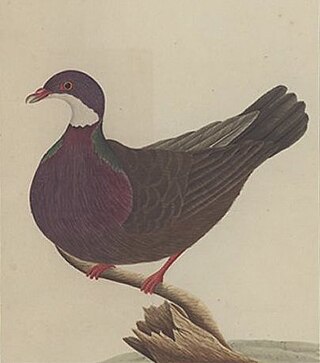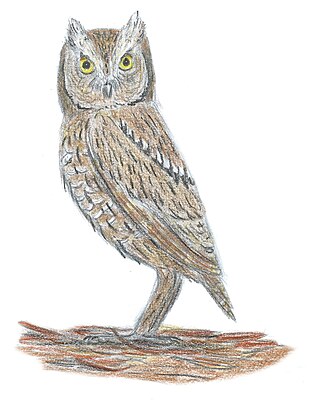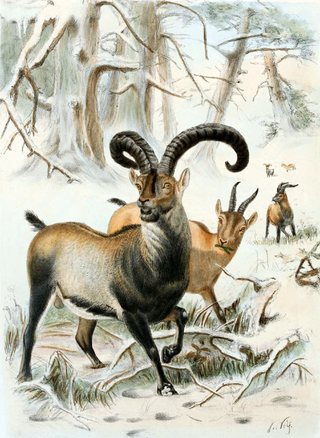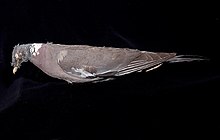
Madeira, officially the Autonomous Region of Madeira, is one of two autonomous regions of Portugal, the other being the Azores. It is an archipelago situated in the North Atlantic Ocean, in a region known as Macaronesia, just under 400 kilometres (250 mi) to the north of the Canary Islands and 520 kilometres (320 mi) west of the Kingdom of Morocco. Madeira is geologically located on the African Tectonic Plate, although its people are descended from Portuguese settlers. Its population was 251,060 in 2021. The capital of Madeira is Funchal, which is located on the main island's south coast.

The common wood pigeon or common woodpigeon, also known as simply wood pigeon, wood-pigeon or woodpigeon, is a large species in the dove and pigeon family (Columbidae), native to the western Palearctic. It belongs to the genus Columba, which includes closely related species such as the rock dove. It has historically been known as the ring dove, and is locally known in southeast England as the "culver"; the latter name has given rise to several areas known for keeping pigeons to be named after it, such as Culver Down. It has a flexible diet, predominantly feeding on vegetable matter, including cereal crops, leading to them being regarded as an agricultural pest. Wood pigeons are extensively hunted over large parts of their range, but this does not seem to have a great impact on their population.

The large bird genus Columba comprises a group of medium to large pigeons. The terms "dove" and "pigeon" are used indiscriminately for smaller and larger Columbidae, respectively. Columba species – at least those of Columba sensu stricto – are generally termed "pigeons", and in many cases wood-pigeons. The rock dove, has given rise to the majority of domesticated pigeon breeds, such as the racing pigeon and the fantail pigeon some of which have become feral. Meanwhile, "wood pigeon" by itself usually means the common wood pigeon.

The trocaz pigeon, Madeira laurel pigeon or long-toed pigeon is a pigeon which is endemic to the island of Madeira, Portugal. It is a mainly grey bird with a pinkish breast; its silvery neck patch and lack of white wing markings distinguish it from its close relative and probable ancestor, the common wood pigeon. Its call is a characteristic six-note cooing, weaker and lower-pitched than that of the wood pigeon. Despite its bulky, long-tailed appearance, this pigeon has a fast, direct flight.

Bolle's pigeon is a species of the genus Columba of family Columbidae, doves and pigeons, endemic to the Canary Islands, Spain. This bird is named after the German naturalist Carl Bolle, who was the first to distinguish it from the laurel pigeon. This wood pigeon is endemic to the laurel forest habitat.

The laurel pigeon or white-tailed laurel pigeon is a species of bird in the Columba genus in the family Columbidae. It is endemic to the Canary Islands, Spain, and resides in laurel forest habitat. It is the animal symbol of the island of La Gomera.

The Bonin wood pigeon was a pigeon endemic to Nakodo-jima and Chichi-jima in the Ogasawara Islands, south of Japan. It is known from four recorded specimens, the first from 1827 and the last from 1889. They averaged a length of 45 cm. This pigeon died out late in the 19th century as a result of deforestation, hunting, and predation by introduced rats and cats.
The Réunion pink pigeon is an extinct subspecies of pigeon that formerly lived on the Mascarene island of Réunion. It is known from the description of a rusty-red pigeon given by Dubois in 1674 and a single subfossil humerus that agrees with that of the pink pigeon of Mauritius in generic characteristics, except being slightly longer. Also, Dubois' reference to the bill being red at the base and the eyes being surrounded by a red ring suggest that this species was closely allied to the Mauritius taxon. Dubois' description was as follows:
wild pigeons, everywhere full with them, some with slaty-coloured feathering [Alectroenas?], the others russet-red [N. duboisi]. They are a little larger than the European pigeons, and have larger bills, red at the end close to the head, the eyes ringed with the colour of fire, like pheasants. There is a season when they are so fat that one can no longer see their cloaca [croupion]. They are very good tasting. Wood-pigeons and turtle-doves, as one sees in Europe and as good.

The Madeiran large white is a subspecies of the large white butterfly, endemic to Madeira. It was described by the English entomologist, Arthur Gardiner Butler in 1886.

The Norfolk pigeon or Norfolk Island pigeon, sometimes called the wood quest, was a subspecies of the New Zealand pigeon (kererū) that inhabited Norfolk Island. This population probably colonized Norfolk Island from New Zealand during the Pleistocene. It became extinct around the turn of the 20th century.

The Lord Howe pigeon, Columba vitiensis godmanae, was a subspecies of the metallic pigeon which existed on Lord Howe Island. It became extinct in the 1850s.

Ernst Johann Schmitz was a German naturalist, ornithologist, entomologist and Roman Catholic priest who settled in Madeira in the late 1870s, serving as vice chancellor of the Funchal Seminary from 1891 to 1898, and again from 1902 to 1908, becoming a naturalised Portuguese citizen. From 1898 to 1902 he worked in Belgium. In 1908 he moved to Palestine to manage the Hospice of St Paul in Jerusalem until 1914, subsequently working in similar positions in Tabgha, Damascus and finally Haifa where he died.

The Madeiran chaffinch is a small passerine bird in the finch family Fringillidae. It is a subspecies of the common chaffinch that is endemic to the Portuguese island of Madeira, part of Macaronesia in the North Atlantic Ocean. It is locally known as the tentilhão.

The Azores wood pigeon, Columba palumbus azorica is an endemic subspecies of the common wood pigeon, located in the Atlantic Azores islands of Portugal. This endemic subspecies is the only live pigeon present in the laurel forest habitat of the Azores Islands.

The Madeiran scops owl is a small extinct owl that once inhabited the island of Madeira in the Macaronesian archipelago off the north-west coast of Africa in the North Atlantic Ocean.
Speckled Wood may refer to:

De-extinction is the process of generating an organism that either resembles or is an extinct species. There are several ways to carry out the process of de-extinction. Cloning is the most widely proposed method, although genome editing and selective breeding have also been considered. Similar techniques have been applied to certain endangered species, in hopes to boost their genetic diversity. The only method of the three that would provide an animal with the same genetic identity is cloning. There are benefits and malefits to the process of de-extinction ranging from technological advancements to ethical issues.

The Madeira evergreen forests is a laurissilva ecoregion of southwestern Europe. It covers the archipelago of Madeira and some nearby islands in the Atlantic Ocean. Laurel forest, known as laurissilva, once covered the islands. Over centuries the laurel forests were mostly cleared. Madeira's remaining forests are now protected.
















